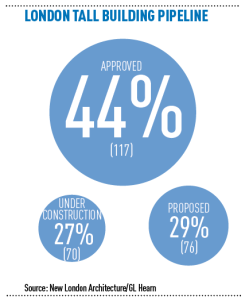 The news that the number of tall buildings planned across London has risen by more than 10% in the past year to 263, and that the number under construction has jumped by nearly half, was met with consternation by some and celebrated by others. Either way, the changing view of the capital was plain to see for the thousands who crowded around the new London model at MIPIM last month.
The news that the number of tall buildings planned across London has risen by more than 10% in the past year to 263, and that the number under construction has jumped by nearly half, was met with consternation by some and celebrated by others. Either way, the changing view of the capital was plain to see for the thousands who crowded around the new London model at MIPIM last month.
New London Architecture chairman Peter Murray has nothing against skyscrapers per se: “I enjoy well-designed tall buildings. The Cheesegrater and The Shard, for example, are great pieces of architecture.” But he is concerned that while individual schemes may be scrutinised in great detail, relatively little thought is being given to how the overall mass of buildings will interact with each other and London’s existing built form.
The NLA’s solution – a Skyline Commission – was rebuffed by London mayor Boris Johnson last year. Murray comments: “We’re still of the view that it would be helpful for the mayor to have as much advice as possible on this matter.” Johnson, mindful of his stated annual target of 42,000 new homes for the capital, may be pleased that four out of five towers planned are for residential use. However, the NLA/GL Hearn report reveals that the skyscrapers under construction will yield just under 15,000 homes – or about one-third of the mayor’s annual target.
Murray believes that the next London mayor – to be elected in May 2016 – faces a stark choice: to build up or build out. While acknowledging that it is politically challenging, Murray says there is huge scope for “densifying” parts of outer London. In the meantime, the battle over individual schemes, such as Bishopsgate Goods Yard, which Murray describes as a “watershed case”, is likely to intensify.
He comments: “Developers will have to be on their mettle and local communities will need to be realistic, but state their case.”
 Nigel Kempner, executive director, Quintain
Nigel Kempner, executive director, Quintain
“London has the fastest-growing GDP and population of any European city. The number of jobs within the capital is expected to increase by 12% over the next five years and there is limited speculative space under development to accommodate the anticipated demand. More tall buildings are inevitable and – as evidenced over the past five years – can make a very positive contribution to the identity of a skyline. Courageous design that is sympathetic to London’s historic context should be welcomed as it adds further value to an already thriving city in which people aspire to work and live.”
 Bill Page, head of business space research, Legal & General Property
Bill Page, head of business space research, Legal & General Property
“For offices, the fundamental question is: Do occupiers prefer high-rise or low-rise? There has been a view that smaller floorplates, fractured demise and high costs make tower space less desirable than a more efficient and larger low-rise floorplate. In parallel, the mood of austerity has meant some occupiers have been nervous about perceptions of profligacy that towers can represent. However, changing space standards and smaller cores have improved efficiency and a trend to see landmark buildings as a recruitment tool and a way of connecting with clients has supported high-rise working. In this regard, more towers can do no harm to London’s reputation – but London has achieved pre-eminence without them. Provided that the business environment, skill base, quality of office accommodation and transport infrastructure are globally competitive, building height should be seen as an extra benefit, not a requirement.”
 Dan Bayley, managing director, central London offices, BNP Paribas Real Estate
Dan Bayley, managing director, central London offices, BNP Paribas Real Estate
“The number of towers proposed for London is a reflection of the capital’s success and the confidence that occupiers and investors, both domestic and international, have in its future. There are very few world cities that have so few office and residential towers as London and what choice is there? We could restrict their numbers and focus on low-rise developments, but this would surely risk additional upward pressure on rents, capital values and land prices.
This is not to say that we should abandon our architectural heritage in favour of bland high-rise development. There is no reason that new architecture cannot produce buildings as impressive as those we already cherish. We should not be afraid to look up in search of solutions to the demand for both residential and commercial space.”
 Jo Valentine, chief executive, London First
Jo Valentine, chief executive, London First
“Whether higher-rise buildings will damage or enhance London’s standing depends on what we mean. Remarkable buildings such as the Shard, the Eye and the Lloyd’s building add to brand London and the feeling of constant revitalisation. Any building needs to be sensitive to the space and people around it. As these buildings are more intrusive, so planners should be more careful, but not less innovative.
Part of the reason these are topical is that higher-rise buildings deliver more efficient use of the same land. We suffer from a lack of office space, with vacancy rates of less than 2% in parts of the Square Mile. We have a chronic shortage of housing. Three-quarters of companies believe London’s housing supply and costs are a significant risk to the capital’s economic growth.
Higher-rise buildings are part of the solution. While 200 tower buildings may sound a lot, London’s skyline remains decidedly low-rise compared with New York and Paris.”











